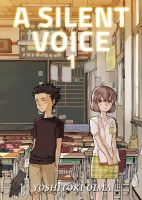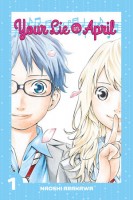It’s been a while since I checked in with Kodansha, so this week I reviewed two recent additions to the KC catalog: A Silent Voice, which explores the complex relationship between a bully and his victim, and Your Lie in April, which focuses on a piano prodigy who flamed out at an early age.
 A Silent Voice, Vol. 1
A Silent Voice, Vol. 1
By Yoshitoki Oima
Rated T, for Teens
Kodansha Comics, $10.99
Thirteen-year-old Shouya Ishida is at loose ends: he’s a mediocre student, a latch-key kid, and a thrill-seeker who goads his friends into dangerous stunts. When deaf girl Shoko Nishimiya joins Ishida’s class, however, Ishida’s recklessness shades into cruelty. He orchestrates a systematic campaign of harassment against her, mocking her speech, stealing her hearing aides, and blaming her for “ruining” the class.
As manga-ka Yoshitoki Oima capably shows, Ishida’s inability to control his worst impulses stems from a toxic mixture of loneliness, frustration, and immaturity. Oima resists the urge to blame Ishida’s mother for her son’s behavior, portraying her as a hard-working, decent woman who’s struggling to run a business and raise two children on her own. Instead, Oima zeroes in the complex dynamic between Ishida and his classmates, acknowledging the degree to which their own hostility towards Nishimiya validates–and encourages–Ishida’s cruelty.
In one scene, for example, the teacher calls on Nishimiya to read a passage out loud. Her words are labored and difficult to understand, prompting uncomfortable stares from the class. When Ishida is asked to do the same, he’s emboldened by his peers’ response. “Uwah! Uwoh! Argle! Bargle!” he declares, feasting on the giggles and snickers his impression elicits. Though the teacher issues Ishida a stern warning, Mr. Takeuchi’s own contempt for Nishimiya seeps into their conversation, granting Ishida further license to harass his classmate.
I’d be the first to admit that A Silent Voice is a difficult read, not least for the scenes in which Ishida torments Nishimiya; Nishimiya’s crestfallen expressions will rip your heart out. It’s a worthwhile series, however, for its truthful exploration of adolescent cruelty, and for its steadfast refusal to paint its troubled protagonist as a monster–or a victim.
 Your Lie in April, Vol. 1
Your Lie in April, Vol. 1
By Naoshi Arakawa
Rated T, for Teens
Kodansha Comics, $10.99
Your Lie in April follows the budding relationship between Kosei Arima, a piano prodigy, and Kaori Miyazono, a violinist who plays by her own rules. When Arima first meets Miyazono, he’s so crippled by his own perfectionism that he can’t play in public. Miyazono, on the other hand, is fearless, giving messy but emotionally authentic performances that irk judges and wow audiences. Miyazono has an equally messy personality–she’s impetuous, petulant, and bossy–but captivates Arima with the sheer force of her enthusiasm.
I’ll be honest: I’d like Your Lie in April a lot more if it focused on a drama troupe or a sports team. That may seem like an odd admission from a musicologist, but Miyazono’s character embodies what I dislike most about popular depictions of classical music. Her eclectic performances are offered as evidence of her “true” musical ability, while the judges’ disapproval is portrayed as a failure of imagination–it’s like Shine in manga form, and boy howdy, did I hate Shine. Why? Because a score isn’t a loose set of guidelines to be followed at the musician’s whim; it’s an explicit representation of the composer’s intentions. Willfully ignoring tempo markings, dynamics, and phrasing misses the entire point of musical notation. Miyazono may make Beethoven’s Kreutzer sonata “unequivocally her own,” but is she really capturing the spirit of the piece by taking so many liberties with it?
Given my own bias, I don’t know if I can give Your Lie in April a fair shake. I found the artwork clean and expressive, and the dynamic between Arima and his non-musical friend Tsubaki Sawabe true to life. (In contrast to Miyazono, Sawabe is not simply a vehicle for the hero’s self-actualization, but a character in her own right.) I also enjoyed the program notes at the end of every chapter–a nice touch for readers who recognize Saint-Saens’ name, but can’t quite tie him to a specific composition or stylistic period. I’m not sure these small pleasures are enough inducement for me to pick up volume two, but a less fussy music lover might well enjoy this coming-of-age drama.
Reviews: Bust out your handkerchief–the final installment of House of 1000 Manga has been posted! Jason Thompson takes a few minutes to reflect on the column, list his ten favorite manga, and discuss what he’ll be doing next. Like many of ANN’s regular readers, I will miss House of 1000 Manga dearly; Shaenon and Jason did a terrific job of sharing their knowledge of and enthusiasm for manga with readers in a consummately effortless style.
Courtney Sanders on vol. 16 of 07-Ghost (Three If By Space)
Connie on vol. 2 of Alice in the Country of Clover: Knight’s Knowledge (Slightly Biased Manga)
Connie on vol. 3 of Alice in the Country of Clover: Cheshire Cat Waltz (Slightly Biased Manga)
Al Sparrow on vol. 1 of The Ancient Magus’ Bride (ComicSpectrum)
Ken H. on vol. 4 of Attack on Titan: Before the Fall (Sequential Ink)
Erica Friedman on Awajime Hyakkei (Okazu)
Connie on vol. 18 of Black Bird (Slightly Biased Manga)
Kate O’Neil on vol. 10 of Black Lagoon (The Fandom Post)
Connie on vol. 28 of Blade of the Immortal (Slightly Biased Manga)
Helen on Cardcaptor Sakura (Organization Anti-Social Geniuses)
Connie on vol. 1 of Citrus (Slightly Biased Manga)
TSOTE on vol. 29 of C.M.B. (Three Steps Over Japan)
Connie on vol. 2 of Demon Love Spell (Slightly Biased Manga)
Rebecca Silverman on Dream Fossil (ANN)
Holly Saiki on Fragments of Horror (Examiner)
Courtney Sanders on Fragments of Horror (Three If By Space)
Ken H. on In Clothes Called Fat (Sequential Ink)
Luke Halliday on vol. 2 of JoJo’s Bizarre Adventure: Phantom Blood (Snap 30)
Rebecca Silverman on vol. 18 on Kamisama Kiss (ANN)
Sakura Eries on vol. 4 of Kiss of the Rose Princess (The Fandom Post)
Johanna Draper Carlson on vol. 14 of The Kurosagi Corpse Delivery System (Comics Worth Reading)
Connie on vol. 5 of Love Pistols (Slightly Biased Manga)
Kristin on vol. 3 of Master Keaton (Comic Attack)
Lesley Aeschliman on vol. 3 of Master Keaton (WatchPlayRead)
Anna N. on vol. 2 of Meteor Prince (The Manga Report)
Sean Gaffney on vol. 1 of Non Non Biyori (A Case Suitable for Treatment)
Al Sparrow on Panty & Stocking with Garterbelt (ComicSpectrum)
TSOTE on vol. 1 of Q.E.D. iff (Three Steps Over Japan)
Matthew Alexander on vol. 9 of Sankarea (The Fandom Post)
Megan R. on Seraph of the End (The Manga Test Drive)
Al Sparrow on vol. 1 of A Silent Voice (ComicSpectrum)
Connie on vol. 34 of Skip Beat! (Slightly Biased Manga)
L.B. Bryant on vol. 1 of So Cute It Hurts! (ICv2)
Matthew Alexander on vol. 9 of Triage X (The Fandom Post)
Connie on vol. 16 of We Were There (Slightly Biased Manga)
Ash Brown on vol. 7 of What Did You Eat Yesterday? (Experiments in Manga)
I find it fascinating to read your impression of A Silent Voice, because the mangaka obviously really brought his viewpoint across – which is the one of the abuser and all the various grey shades that go into it. What I don’t hear about is the victim. And that’s why I’m highly unlikely to read this ^^.
Admittedly I don’t really read manga for the purpose of being confronted with real life issues and working through them, so it was unlikely I’d have picked it up anyway.
Hi, Estara! Oima does show us how Nishimiya reacts to Ishida’s harassment–those images are genuinely wrenching, as they demonstrate how bewildered and isolated she is. I found that a more powerful artistic choice than revealing Nishimiya’s thoughts through dialogue, voice-overs, or diary entries; it speaks to the great strength of the comics medium that an author could simultaneously relate how both victim and bully feel.
From what I understand of later volumes, Nishimiya becomes a more fully developed character with greater agency. I’ll be interested to see how Oima portrays her in (young) adulthood.
Wow, this is a series running into YA? Well, it must speak to something. Looking forward to future post of yours about this.